The Campfire Hardcore Hunting Backpack Review
by Scott Reekers
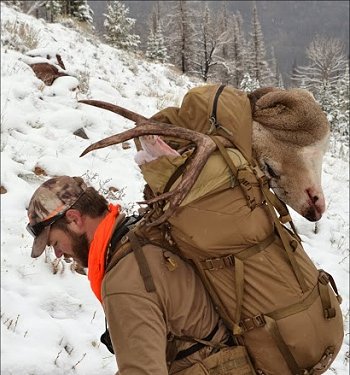
EVERY HUNTER WANTS to have the best pack on the market. The higher the price tag, the more a buyer is likely to defend it. Some will try to promote their favorite to every hunter around, and most every online hunting forum will know what gear is going into the woods with that hunter in the fall. With so much chatter on which pack is best, how is a hunter supposed to sort through the information to determine what is best for his needs and hunting style?
For the hunter who is willing to spend the money on a high-end pack, there have never been so many options, which makes choosing a pack even harder. Kifaru and Mystery Ranch, as the reigning champions, sit on top of the heap, with new challengers Stone Glacier and Paradox trying to take a bite out of market share. With options come questions, and even confusion, for potential buyers. This usually ends with hours spent in front of the computer asking: “Which one is right for me?”
To help you sort through which pack is best for the three-to-five-day backcountry hunt, we put serious miles on the Kifaru Highcamp 4800 with Bikini frame, the Mystery Ranch NICE Metcalf, the Paradox Evolution, and the Stone Glacier Solo.
All four of these packs were picked based on their claimed ability to carry 100-pound-plus loads, with frames that can attach multiple pack-bags, and their being load-shelf capable. Based on manufacturer’s descriptions, the packs also had to be able to carry enough gear and food to sustain a hunter for three to five days or more in the backcountry. There are other companies fighting to be in this market, but these four are getting serious attention in the online hunting world.
The testing method for each pack:
- 15 miles in a variety of terrain with normal loads in the 25- to 50-pound range.
- 10 miles in a variety of terrain with heavy loads of 80 pounds plus, and at least one trip carrying more than 100 pounds.
- Each pack was used for at least 50 miles of travel. The Metcalf, Highcamp, and Solo were all purchased at full retail.
- The Paradox was a prototype provided for testing, and we have since shipped it to the next field tester.
The categories we used to review each pack:
- Value For The Price: How much are you really getting for your high end pack? A hunter who spends $600 on a pack should not wonder, “Why did I pay this much?”
- Customer Service: How did each company do when we dealt with them? How good is their warranty should something break? Were they timely in their communication with us?
- Features of the Pack: As subjective as this category may sound, we all have certain things that matter in a pack. The features that matter to the reviewers will make up this portion of the score.
- Harness/Yoke Comfort: How comfortable was this pack on the shoulders? Did the yoke system stay in place? Did the shoulder straps dig in, or did they drape comfortably over the shoulders?
- Belt Fit/Comfort: Did the pack lock in place, comfortably putting the pack weight squarely on the hips?
- Comfort With A Normal Load: How comfortable was each pack with a three-to-five-day load of gear and food?
- Comfort With A Heavy Load: This is where the rubber meets the road. Every hunter wants to come out from a backcountry hunt with a full load of meat. Most of the time that means a pack weight of over 80 pounds. How comfortably did each pack haul the heavy loads?
- Compression System: How well did each pack’s compression system keep the load in place?
- Ease of Use: How easy was it for us to get each pack tuned in to our body type?
- Durability: Were we able to break anything? Did we notice any abnormal signs of premature wear and tear?
Reviewers gave each pack a score from 1 to 10 in all of the categories listed, for a possible total of 100 points, then scores for each pack were averaged for a final score.
STONE GLACIER SOLO
Specifications:
- Size of Bag: 3,300 cu in
- Load Shelf Capacity: 2,000 cu in
- Claimed Weight: 3 lb, 9.6 oz
- Actual Weight: 3 lb, 8 oz
- Frame/Stays: Four carbon composite stays encased in X-Pac material
- Belt Style: Hybrid full wrap/lumbar pad
- Price: $559
- Overall Final Score: 79.75
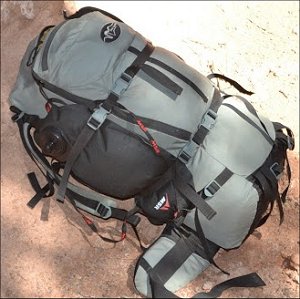
The Stone Glacier Solo is built with the minimalist backpack hunter in mind. Kurt Racicot started making his line of packs after modifying several pack bags and frames to meet his particular needs. He firmly believes in the load-shelf concept, and the Krux frame evolved from there. Kurt lived in Alaska hunting sheep and goats and learned the value of a pack that keeps the heavy meat close to the body and provides plenty of shoulder lift. The Krux frame does just that with four carbon composite stays encased in black X-Pac material.
The belt and harness both attach to the frame with the use of industrial-grade Velcro for easy adjustment to fit a wide range of users. The frame system is given a 130-pound-plus rating by the manufacturer, with videos and pictures on their website claiming it can hold much more.
The Solo bag is a combination of grey 500D Cordura and black X-Pac material. The X-Pac lines the back of the bag to prevent blood stains when the load shelf is used to haul meat. Moreover, as a laminate material, X-Pac is easy to clean. This makes removing bloodstains and meat grime from the load shelf an easy process. However, X-Pac can be noisy, especially in cold weather, so the rest of the bag is constructed of quieter grey Cordura.
The Solo uses a panel-loading design which offers easy access to all of the gear. A heavy-duty YKK #10 zipper keeps the load securely inside of the bag, while three lateral compression straps hold gear and meat in place.
What We Liked:
Out of the box, the spartan style of the pack was obvious in design, weight and function. There is no excessive flare or material to make this a complicated pack. This is a very basic design intended for the minimalist hunter.
With a fully loaded bag at weights between 35 and 50 pounds, the pack functioned perfectly. The Solo is easy to load, easy to access, and offers just enough organization for the little pieces of gear in the top pocket and silnylon pocket interior pocket.
Because the frame was designed to use the load shelf, getting a heavy load onto the frame is easy. Stone Glacier integrated multiple access points between the Krux frame and the bag, which compresses whatever is on the shelf.
To test just how well the bag compressed a heavy load, we loaded it full of gear and placed sand bags on the load shelf. The compression system performed well and kept the awkward load in place. The frame’s compression system also made it very easy to attach bulky items, like an MSR Dromedary bag or a 85-mm spotting scope, to the side of the bag. Being able to easily attach large items to the outside of the bag opens up space on the inside for clothing or shelters.
The frame’s flex was also a nice change of pace. Some packs can be so rigid that a two-by-four piece of lumber articulates better with the user’s back. The composite stays flexed well, and, combined with the easy-to-adjust shoulder harness, provided plenty of comfort against the back. The stays were also stiff enough to support the heavy load, even when cinched tightly. The flex helped the frame match the curve of the back without creating pressure points or hot spots.
What We Didn’t Like:
We both wished the belt was a little longer, as Stone Glacier currently offers only one size. A larger belt would have wrapped around the front of the hips better, providing more support under heavy loads.
Under the heavy loads, we both would have liked the belt to have more contact with the lower back. More contact evenly distributes weight to the proper place — onto the hips and the small of the back.
After talking with Kurt about the belt issues, he sent the accessory lumbar pad to address the contact problem. The pad works very well, and he had us move the belt lower on the frame, which made it more comfortable. A simple solution would be to make the removable lumbar pad standard on the pack. This might potentially raise the price, but would eliminate the need to have to order it separately later.
The inside of the pack offers a silnylon pocket to hold smaller pieces of gear and provides good organization. However, a zipper or a full line of Velcro rather than the two-inch horizontal Velcro strip that is in the current model would be worth the weight penalty. Because the pocket is flipped over when opening the main compartment, it is very easy for gear to fall out of the pocket. This happened several times in the gear room as well as while packing on the mountain.
The pocket on the top of the lid is great for small items but could be a little bigger. Stone Glacier does offer belt pockets and several other accessory pouches, but as a base pack, just a little more organization space would be nice.
Buy this pack if: You are truly a minimalist hunter who likes to move light and fast but wants to be prepared to haul meat out of the backcountry. This pack could also work for you if you do not mind add-on pockets for the “extras,” bearing in mind the inherent weight penalty.
Do not buy this pack if: You like creature comforts on a backcountry hunt. The pack’s small size will limit how many “extras” you can fit. When the Solo was used on an overnight scouting trip, even though the shelter and sleeping bag were a bit more than required, an otherwise basic kit filled the bag. For a week-long trip, use of the load shelf would be required for food.
KIFARU HIGHCAMP 4800 WITH BIKINI FRAME
Specifications:
- Size of Bag: 4,800 cu in
- Load Shelf Capacity: n/a
- Claimed Weight: 4 lb, 7 oz
- Actual Weight: 4 lb, 11.2 oz
- Frame/Stays: Two vertical and two horizontal wood-laminate stays Belt Style: Kifaru lumbar pad and belt with Packlock.
- Price: $685 Final Score: 79.75

Kifaru International designed the Bikini frame and Highcamp bag combination for the hunter who wants to cut weight from his pack setup without losing comfort under a heavy load. The company has sold many packs and frames over the years on their reputation as a comfortable pack. The Bikini frame follows that tradition and is a well thought out, rigid frame capable of carrying heavy loads comfortably.
The Bikini Frame uses two vertical carbon-fiber and laminate-wood stays to support the load, and two smaller horizontal stays to keep the vertical stays aligned. The lumbar pad and belt are attached by a rugged encasement at the bottom of the stays. Unlike other Kifaru models, these stays are not interchangeable. Velcro attachments hold the lumbar pad in place and can be undone to adjust the height of the shoulder harness to match the user.
The stays themselves can be ordered in either 24-, or 26-inch lengths. Anyone above 6’1″ would be wise to order the longer version to keep heavy loads off the shoulders. The 26-inch stays provide plenty of lift, even for taller users.
The bag is constructed of 500D Cordura, and we chose the Kryptek Highlander camo pattern. The top access is large enough to fit the bulkier pieces of gear without much hassle. The bottom access is big enough to stuff in a sleeping bag, although a stuff sack for the sleeping bag is required since there is no integral partition in the Highcamp to keep the sleeping bag contained.
What We Liked: The size of the bag was perfect for the three-to-five-day trip category, and the combination of top and bottom loading made packing easy. If the bag is too full to carry meat then the load shelf is available to get everything out in one trip.
The power pulls on the belt are also a very nice feature that make cinching the belt down simple. Kifaru recommends that the belt be pulled as tight as possible, and the power pulls make it much easier than a standard belt to achieve that. The power pull system allows the user to cinch down the belt across rather than away from the body. The science on why it works is simple and helps the belt perform the way it should.
The 26-inch Bikini frame offers plenty of shoulder lift and planted heavy loads squarely on the hips. When the belt was cinched tightly, we did not experience any “belt slip” or discomfort on or around the hips. This is a plus, especially when going downhill with a bulky load of meat or a full week’s worth of gear.
During day hunts away from camp, reviewers used the bottom zipper more than the main lid to access the main bag. The bottom opening is big enough to pull through a spotting scope, tripod or puffy jacket and is well placed for quick access when glassing from a hillside.
What We Didn’t Like: The lumbar pad can be stiff at first, and takes some time to really break in and soften up for a comfortable ride. Once softened, it is comfortable, but it takes several miles for it to reach that point.
With the exception of the chamber pocket, all other organization would have to be done through dry bags or the additional pockets offered by Kifaru. Integrated pockets would have a lower weight penalty but also would raise the price point. Integrated pockets would make the bag less modular, but reviewers would have liked to see some minimal organization capability included.
Reviewers experienced pressure on the shoulder blade from a lack of padding where the shoulder harness meets the frame. With some work we were able to improve the fit but we still experienced the problem when working with a heavier load. This likely will not be an issue for shorter users, but for bigger users, it was. Is it a deal breaker? No. Did it affect comfort? Yes.
Neither reviewer particularly cared for the G-Hook system that is standard on the Highcamp bags. The G-Hook is a lightweight/high-strength option that hooks into sewn-in loops rather than the standard buckles other packs used. The hooks take a little more time to employ, and a backpack hunter could get used to them, but we would likely switch them out for standard buckles.
At this price point, reviewers also would have liked to see the load shelf come standard with the bag rather than as an add-on. Also, the load shelf could have been made easier to access. Kifaru uses loops and tri glides to attach the bag to the vertical stays on the frame, and the bag stays in place incredibly well. However, for a pack that can be used with a load shelf, a quicker detatchment would be nice.
Buy This Pack If: You are a fan of a modular platform with a very lightweight starting point. This pack is also good for people who like the lumbar pad style belts that wrap around and contour the hips.
Don’t Buy This Pack If: You prefer the full wrap belt system. The lumbar pad likley will feel bulky and unnecessary. This pack also is not for hunters who want organization integrated into the bag.
MYSTERY RANCH N.I.C.E. METCALF
Specifications:
- Size of Bag: 3,600 cu in (without top lid); 4,500 cu in (with top lid)
- Load Shelf Capacity: N/A
- Claimed Weight: 6 lb, 15 oz (with top lid*)
- Actual Weight: 8 lb Frame/Stays: Mystery Ranch NICE
- Frame with three horizontal aluminum stays
- Belt Style: Contour Lumbar Wrap
- Price: $559
- Final Score: 74.5 *This is the claimed weight without the additional pockets on the waistbelt. We upgraded the waistbelt for more organization that accounts for some of the weight discrepancy.
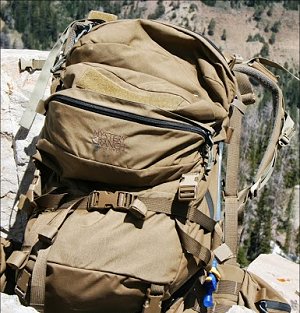
Mystery Ranch has taken some criticism for their NICE frame’s short height and the heavy weight of their pack bags in recent years. In response to this criticism, the company answered with the Metcalf bag. With a built-in frame extension to provide shoulder lift and a simple, single compartment bag with one silnylon pocket to cut weight, the end result is their lightest expedition pack. Nevertheless, it was the heaviest bag in our review.
Mystery Ranch is known for building arguably the toughest packs on the market, and the Metcalf is no exception. It is constructed with 500D Cordura and uses the same sewing standards as the rest of their line. We chose the Coyote Brown color and opted to keep the lid attached for all testing. The lid offers two large pockets that provide some organization as well as top compression, good for holding a jacket or other bulky items.
The compression system is built with eight separate straps that can be yanked and wrestled with to get the load under control. The heavy-duty nature of the compression system allows the bag to be stuffed full, and the load will not shift.
The shoulder harness is easily adjusted, and with the proper size will fit most users. The belt is in the same category, easily sized and cinched into place. Mystery Ranch’s site and ordering process makes finding the right size easy, and dealing with their customer service department over the phone was a great experience.
What We Liked: The Metcalf does not lack organization, with the most integrated pockets throughout the bag of all the packs in this review. The top lid offers two large pockets, as well as a compartment for a mid-sized water bladder. We also upgraded the belt for a little more built-in organization in two small waist pockets. We used these pockets for things like a range-finder, maps, tags, or elk calls. The inside of the bag has a bladder pocket and a silnylon zippered pocket that helps to organize small items on the inside of the bag.
The side zip access is great for loading the pack with bulky things like an 80mm spotting scope or compressed cold-weather sleeping bag. It opens wide and makes loading the pack an easy process. Most lightweight, single-main-compartment bags are top-load only, or use some type of sleeping-bag zipper on the bottom. The zipper on the Metcalf runs vertically up the entire bag and makes filling the gaps in between pieces of gear easy.
We expected the Metcalf to be tough, and, as advertised, it was. Not a single seam ripped or groaned when loaded with large mule-deer quarters plus cape and antlers. The bag took all of the abuse we could throw at it and never complained or looked worse for wear.
What We Didn’t Like: The Metcalf was the heaviest pack we tested. In order to maintain their brand of the toughest packs on the market, Mystery Ranch is willing to take the weight penalty. If this pack were to stay in our gear closet for use year after year, the knife and scissors would have to come out to remove all of the excess length on the straps, and in particular, the Daypack Top Lid. We would cut off the top lid’s shoulder straps, remove the foam insert, and possibly cut out some of the redundant layers inside the pockets. To be fair, we also added a weight penalty on our own with the upgraded waist belt pockets. That weight penalty was worth the extra organization.
The meat-shelf option on the Metcalf loses one of the best of the Metcalf’s qualities. The load lifters are directly attached to the bag itself, and when a meat quarter or a dry-bag full of gear is put into the load shelf, the bag’s load lifters are no longer attached to the frame. The two inches of shoulder lift gained by using this bag are lost in the load-shelf configuration. This transfers much of the pack’s weight onto the shoulders, rather than the hips where it belongs.
When cinched down tight, the top lid also has a habit of pulling forward, exposing the snow collar and not sitting correctly on top of the bag. When the bag is stuffed full of gear or meat this is not an issue. However, if the bag is not filled to the brim, or the lid is holding gear that should not be exposed to rain or snow, it could be a problem
One reviewer could not get the waist belt to cup his hips and felt like the belt lacked lumbar support when the pack was loaded with more than 75 pounds. For trips under two miles, this was not an issue, but beyond that it was noticeable. If the lumbar support were more prominent, the waist belt would sit perfectly.
Buy This Pack If: You are the kind of hunter who is very hard on your gear. The Metcalf and NICE frame will take all of the abuse you can throw at it and still haul your kill out of the woods. This pack is also good for the hunter who needs a little more organization on the main bag than the other packs in this review.
Don’t Buy This Pack If: You want to go in light and fast by building your backpack hunting system from a light pack out. Super-tough gear often comes with a weight penalty, and the Metcalf/NICE system is no exception.
PARADOX EVOLUTION
- Specifications: Size of Bag: 6,300 cu in
- Load Shelf Capacity: N/A
- Claimed Weight: 4 lb, 1.4 oz
- Actual Weight: 4 lb, 11.2 oz
- Frame/Stays: 28-inch articulating tubular aircraft aluminum frame
- Belt Style: Paradox full wrap
- Price: $599
- Final Score: 78.75
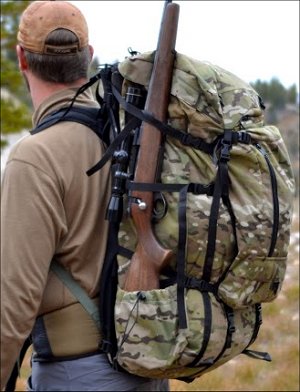
We were lucky enough to receive one of the first test models of the Paradox Evolution for this review. Some changes have been made with the first production runs, but for the most part the pack we had is the pack that has been produced.
Paradox Packs are built around function, plain and simple. The owners, Kevin Timm and Nathan Coleman, used the ultra-lightweight concept and made the bags simple, to reduce weight while providing a sturdy load-hauling platform. The Evolution frame is built around articulating tubular aluminum with a 28-inch maximum height. Shoulder lift is possible for even the tallest users, putting the weight of the load onto the full wrap belt. The frame also has the ability to be shortened for day trips or busting brush where catching overhanging branches with the frame is a concern.
The belt is attached to the frame with two double-box-stitched straps that allow the belt to articulate forward and match the curvature of the user’s back. The belt is constructed of two foam materials of different densities to pad and curve around the waist comfortably.
The bags themselves are constructed primarily of X-Pac material in either grey or multi-cam colors. X-Pac’s advantage is that it will not wet out in rainy conditions, and it is much easier to clean after meat has left a bloody mess on the inside. The 6300 bag has a v-shape appearance from the side, rather than the traditional pear shape that many other brands use.
Small pieces of gear can be organized using the Day Talon bag, which separates from the main bag as a day pack with its own shoulder harness. The Day Talon has a pocket for maps, small gear, and one large compartment in which most 50-65mm spotting scopes will fit.
What We Liked: The Evolution was the second-lightest pack we tested. Paradox aimed for the lightweight market, and they got there with their first pack. It also managed to be the pack with the largest main compartment as well. In terms of sheer volume-to-weight, this pack really is lightweight.
The dual-density articulating waist belt is very comfortable and places the load squarely on the hips. The belt stayed in place and did not slip, even under 100-pound loads. For the backpack hunter this is incredibly important when packing out heavy loads of meat.
The versatility of the Evolution frame creates multiple load-out configurations using the packbag alone, the Talon alone, or the packbag/Talon and load-shelf together. The Day Talon added organization to the outside of the bag that could be easily removed and carried. The 6300 bag has big side pockets which securely hold the end of a rifle or a water bottle. Organization is a strong suit for the Paradox.
What We Didn’t Like: Reviewers did not like the attachment points for the top lid. It would have been preferred for the lid to attach directly to the bag, or to find a way to place the attachment points more widely. Without this, under a tall load the lid fell off center at times, and folded in the center at other points. Paradox has modified the production lid from what we received, but we have only used the first edition.
The compression system performed very well and can function without any of Paradox’s Talon daypacks. This creates very long compression straps that are a pain to get under control. In future models we would love to see some type of Velcro retainers sewn into the compression system. This is more of annoyance than a real complaint, but it is worth mentioning for hunters who like to have everything nice and tidy.
The knock on X-Pac is that it tends to be noisy, especially in colder conditions. To find out if this was true, we took the bag off the frame and stuffed it into the freezer for a few hours. Once removed, it crackled and rustled more than it did in warmer temperatures. With time, X-Pac will lose some of its stiffness, similar to a well used paper bag from the grocery store. This is the trade-off for a waterproof packbag.
An issue with testing a prototype is that our feedback was used to make modifications, and that means we do not get to see the final product model right away. Paradox’s shoulder harness falls into this category. We wanted more padding, and after communicating with Paradox, this was changed. We can only comment on the harness we used, and we both wanted more padding.
Buy This Pack If: You are looking for a lightweight, large-capacity waterproof bag. This pack will also be good for hunters and backpackers who have issues with other belts slipping. This belt is different and it may not slip on you.
Don’t Buy This Pack If: You are most comfortable with a large lumbar pad in the belt. The full-wrap belt will fit many people well, but if you are a lumbar pad fan, it may not work.
Wrapping Up
Each pack did well in certain areas, and each pack had areas that we would improve upon. To show just how each pack did in each of our categories, we put together graphs to show how we individually scored each pack. Each area reviewed is a different color and shows every category. As you decide on which pack may be right for you, we encourage you to take a hard look at the graph and evaluate what matters the most on your backpack hunts. If it scored well in the categories that meet your needs, then it will be much easier to press the “Order” button!
None of the packs received a perfect 10 in any of the categories, and none received lower than a 5 in any category. None of the packs are a bad option; these are some of the top-tier packs on the market. Reviewer Number 1’s Scores:
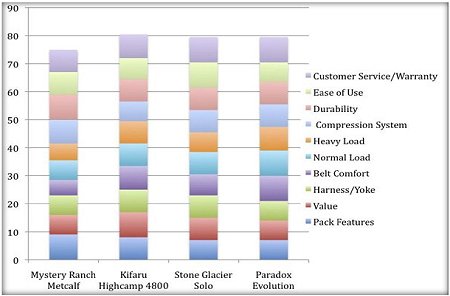
Reviewer Number 2’s Scores:
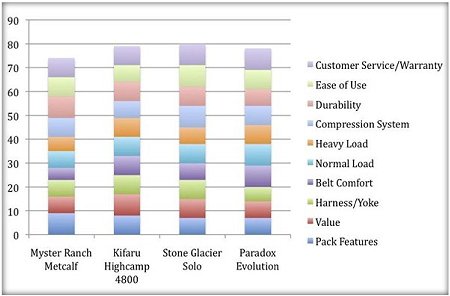
We can easily recommend any of these packs. Every pack comes from a quality company that makes a quality product. Buy the pack that meets your needs and matches your hunting style. Take a hard look at each pack and know that you bought the best pack on the market for how you hunt!
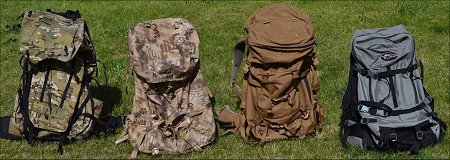
About the Reviewers:
Scott Reekers is a Wyoming native who has been backpacking and hunting with his Dad since elementary school. High-country mule deer and elk are his favorite animals to hunt and photograph. In a typical year, he will pack out between five and ten animals with friends and family. Scott puts hundreds of miles on his boots. He has written for several outdoor and hunting blogs and was recently published in Backcountry Journal, and he has tested gear for Seek Outside. More gear reviews are coming.
Nevada Amack has been rucking heavy loads in the military for twelve years and has spent time using numerous packs and gear to sustain multi-day missions in a variety of places and environments. Survival skills for the backcountry are a passion, and he is comfortable in just about any environment the world has. __________________________________________________
Ask Scott Reekers Questions About “THE CAMPFIRE HARDCORE BACKPACK HUNTING REVIE
Stay Connected
- Got a Break in the Montana Missouri Breaks
- It Took Six Days but We Finally Slipped One Past the Bears and Wolves
- No Mule Deer This Fall – Whitetail TOAD!
- An Accounting of Four Idaho Bulls (Elk)
- Arizona Deer Hunt 2019: Good Times with Great Guys
- Caught a Hornady 143 ELDX Last Night
- Cookie’s 2019 Mule Deer Photo Run
- Let’s See Some Really Big Deer
- Alaskan Moose Hunt Success!
- Take a Mauser Hunting: An Important Message From The Mauser Rescue Society!
- Welcome 16 Gauge Reloaders! Check In Here.
- Off-Hand Rifle Shooting – EXPERT Advice
- BOWHUNTING: A Wide One!

